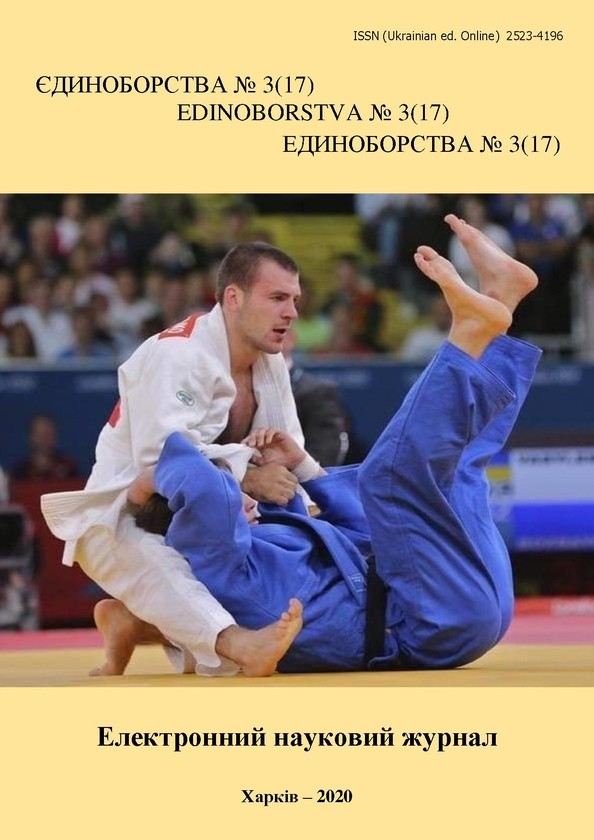Optimization of defensive actions by sloping backward from direct punches in shock martial arts
DOI:
https://doi.org/10.15391/ed.2020-3.05Keywords:
efficiency, protection, tilt back, displacement, optimization, martial arts, movement, biomechanicsAbstract
Purpose: to identify the optimal protective actions by sloping backward from direct punches in shock types of martial arts. Material and methods. The study involved students engaged in the sports and fitness section of Fight Fitness (n=20), 11 boys and 9 girls, aged 18-21 years. The videos of the process of performing protection against a strait punch to the head were taken: a) by tilting the torso backwards, b) by moving the body backwards with turning to the side. Using the special computer program «BioCalculation» (determination of biomechanical characteristics in shock martial arts), the distance of displacement of the head and pelvis of students (by control points) were determined, and a comparative analysis of the results were carried out. Research methods: theoretical analysis of scientific and methodological literature, pedagogical observations, expert assessment method, instrumental method, mathematical data processing. Results: the study found: 1) when performing protection by tilting the torso backward, the head moves backward and the pelvis moves slightly (the average head movement distance was 46.7 cm (boys) and 36,1 cm (girls), the movement of the pelvis was 11,4 cm (boys) and 8,1 cm (girls); 2) when performing protection by movement backwards with turning the body to the side, the average distance of the head movement was 59,3 cm (boys) and 43,2 (girls), and of the pelvis – 34,4 cm (boys) and 26,8 cm (girls). Theoretically and practically substantiated, the effectiveness of using of protection by moving backward with the body turning to the side. Conclusions. Based on the results obtained, the advantage of performing protection by moving backward and turning the torso to the side is obvious. The results of a comparative analysis show that when a protective action is performed with a slope backward with a turn, the head displacement is 27,0 % (boys) and 19,7 % (girls) more than when this protection was performed without turning. According to experts, tilting back with a turn is more effective due to a more stable position (stance) and the possibility of a counterattack.
References
Адашевский, В. М., Ермаков, С. С., & Морачковский, О. К. (2002). Некоторые методы моделирования биокинематических характеристик тела спортсмена. Педагогіка, психологія та медико-біологічні проблеми фізичного виховання і спорту, 25, 82-89.
Ашанин, В. С. (2000). Биомеханика : учеб. пособие. Ч. 1: Общая биомеханика (курс лекций и метод. указания к решению задач). ХаГИФК, Харьков.
Дубровский, В. И., & Федорова, В. Н. (2008). Биомеханика. Учебник для студентов среднего и высшего учебных заведений по физической культуре. 3-е изд., Владос-Пресс, Москва.
Ермаков, С. С. (2010). Біомеханічні моделі ударних рухів у спортивних іграх у контексті вдосконалення технічної підготовки спортсменів. Теорія і методика фізичного виховання, 4, 20-24.
Лапутін, А. М., Носко, М. О., & Кашуба, В. О. (2001). Біомеханічні основи техніки фізичних вправ. Наук. світ, Київ.
Лапутін, А. М., Гамалій, В. В., Архипов, О. А. & ін. (2001). Біомеханіка спорту: навч. посібник. Олімп. літ., Київ.
Мунтян, В. С. (2013). Использование силы упругой деформации мышц при выполнении контратакующих ударов. Проблемы и перспективы развития спортивных игр и единоборств в высших учебных заведениях, 245-247.
Мунтян, В. С. (2015). Биомеханическая модель выполнения защитных и контратакующих действий (от прямых ударов руками и ногами). Проблемы и перспективы развития спортивных игр и единоборств в высших учебных заведениях, 1, 83-87.
Попов, Г. И. (1991). Взаимосвязь волновых процессов управления и исполнения в движениях многозвеньевых биомеханических систем. Биофизика. 36 (2), 344-347.
Попов, Г. И. (2013). Биомеханика. Учебник. Академия, Москва.
Рид, Э. С. (1990). Уроки по теории действия : физиол. исслед. : Управление движениями. 7-9.
Романенко, В. В., & Веретельникова, Н.А. (2019). Оценка биомеханических характеристик в ударных видах единоборств с помощью мобильного компьютерного приложения. Единоборства, 2(12), 48-57.
Adashevskiy, V. M., Iermakov S. S., & Marchenko, A.A. (2013). Biomechanics aspects of technique of high jump. Physical Education of Students, 2, 11-17.
Muntian, V. S. (2013). Definition of biomechanical parameters of technical actions in the martial arts. Physical education of students, 4, 63-67.
Fuchs P., Lindinger S. & Schwameder H. (2018). Kinematic analysis of proximal-to-distal and simultaneous motion sequencing of straight punches. Sports Biomechanics, Volume 17, Issue 4, р. 512-530.













